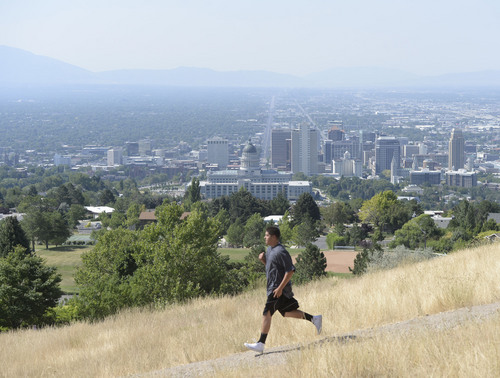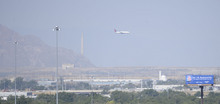This is an archived article that was published on sltrib.com in 2014, and information in the article may be outdated. It is provided only for personal research purposes and may not be reprinted.
As Utah faces — and expects to fail — upcoming federal smog standards, Rep. Becky Edwards is vowing to bring back a bill that would allow the state to adopt air quality rules that are more stringent than federal regulations.
Her previous proposal, HB121, was one of the most closely watched of some two dozen air quality bills during the 2014 Legislature. It was defeated as critics warned of unintended consequences and argued Environmental Protection Agency (EPA) rules are sufficient.
At Wednesday's meeting of the Natural Resources, Agriculture and Environment interim committee, Rep. Susan Duckworth, D-Magna, made a motion to adopt Edwards' new proposal as a committee bill, making it a priority when the 2015 Legislature opens in January.
But other lawmakers gave the idea a cooler reception.
"The concerns [with the 2014 bill] was that there wasn't enough input from the industry and that it could be a job killer," said Sen. Ralph Okerlund, R-Monroe. "Maybe it would be better off to go through a committee hearing. We need further discussion."
The discussion convinced Duckworth to withdraw her motion.
Edwards, R-North Salt Lake, said she has worked with community advocates and industries while crafting the bill.
"The EPA continues to move the goalposts," she said. "If that will continue, what Utah needs is the ability to run different plays. It gives us flexibility."
Division of Air Quality Director Bryce Bird has said federal regulations are rarely based on modeling relevant to Utah's mountain valleys and winter weather.
With the EPA 15 months away from announcing new federal smog standards, Bird told the committee Wednesday, division officials already expect the state will fail to meet the requirements.
"This is something we see coming down the road," Bird said. "We are building up our technical capabilities to be able to provide information as they set up a standard."
Bird told the committee summer ozone monitoring in rural locations is already above the level the EPA is considering for new federal standards.
The federal agency was ordered by a federal judge to issue ground-level ozone standards by Dec. 1, 2014, and create a final rule by Oct. 1, 2015. The order came after environmental groups sued the Obama administration for failing to issue a new standard by March 2013, as required by the federal Clean Air Act.
The committee asked Bird about contributing factors to ozone, the leading factor in summer smog conditions, and what steps are being taken to address Utah's concerns about the pending federal standards.
"If there is no way to attain the standards with our efforts to keep the air clean and it becomes law and the requirement, then all we are doing is piling the cost onto consumers and killing jobs for no reason," Okerlund said.
Ozone is created when ultraviolet light interacts with "precursor" pollutants, generally those associated with combustion engines and compounds from solvents and paints.
Bird told the committee his agency is compiling data and will share it with other western states while preparing for a formal comment period, congressional hearings and "eventually a [legal] fight if it is needed."
The Associated Press contributed to this story.









